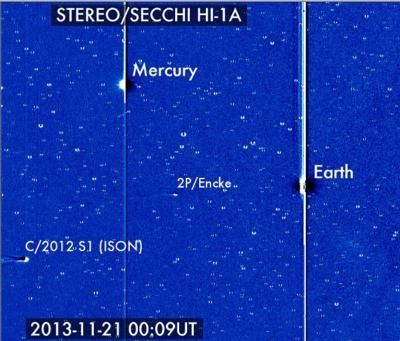Tue, Nov 26, 2013
Comet Will Slingshot Around The Sun Thanksgiving Day
It began in the Oort cloud, almost a light year away. It has traveled for over a million years. It has almost reached the star that has pulled it steadily forward for so long. On Thanksgiving Day, Nov. 28, 2013, Comet ISON will finally sling shot around the sun. Here its inward journey through the solar system will end -- either because it will break up due to intense heat and gravity of the sun, or because, still intact, it speeds back away, never to return.

Catalogued as C/2012 S1, Comet ISON was first spotted 585 million miles away in September 2012. Scientists were instantly intrigued, not because spotting it so far away meant it might be very bright and beautiful once it was closer to Earth -- though this may indeed turn out to be the case if it survives its trip around the sun -- but because this is ISON's very first trip into the inner solar system. That means it is still made of pristine matter from the earliest days of the solar system's formation, its top layers never having been lost by a trip near the sun. Along Comet ISON's journey, NASA has used a vast fleet of spacecraft and Earth-based telescopes to learn more about this time capsule from when the solar system first formed.
During the last week of its inbound trip, ISON will enter the fields of view of several NASA Heliophysics observatories. Comet ISON will be viewed first by the broad field of view seen by NASA's Heliospheric Imager instrument aboard its Solar Terrestrial Relations Observatory, or STEREO, Next the comet will be seen in what's called coronagraphs, images that block the brighter view of the sun itself in order to focus on the solar atmosphere, the corona. Such images will come both from STEREO and the joint European Space Agency/NASA Solar and Heliospheric Observatory, or SOHO. Then, NASA's Solar Dynamics Observatory, or SDO, will view the comet for a few hours during its closest approach to the sun, known as perihelion. The X-Ray Telescope on the JAXA/NASA Hinode mission will also be looking at Comet ISON for about 55 minutes during perihelion.
All of these observatories will have different views. STEREO-B will be the only one that sees the comet transit across the face of the sun. In SDO's view, the comet will appear to travel above the sun, and the SDO instruments will point away from the center of the sun to get a better view for three hours on Nov. 28. In addition to learning more about the comet itself, these observations can make use of the comet as a tracer to show movement in the solar wind and solar atmosphere.
(Image provided by NASA)
More News
Airport Rotating Beacon A visual NAVAID operated at many airports. At civil airports, alternating white and green flashes indicate the location of the airport. At military airports>[...]
Aero Linx: Fly for the Culture Fly For the Culture, Inc. is a 501(c)(3) non-profit organization that serves young people interested in pursuing professions in the aviation industry>[...]
Klyde Is Having Some Issues Comprehending The Fed's Priorities FMI: www.klydemorris.com>[...]
Also: Viasat-uAvionix, UL94 Fuel Investigation, AF Materiel Command, NTSB Safety Alert Norges Luftsportforbund chose Aura Aero's little 2-seater in electric trim for their next gli>[...]
Also: EP Systems' Battery, Boeing SAF, Repeat TBM 960 Order, Japan Coast Guard H225 Buy Despite nearly 100 complaints totaling millions of dollars of potential fraud, combined with>[...]
 ANN's Daily Aero-Term (04.25.24): Airport Rotating Beacon
ANN's Daily Aero-Term (04.25.24): Airport Rotating Beacon ANN's Daily Aero-Linx (04.25.24)
ANN's Daily Aero-Linx (04.25.24) Klyde Morris (04.22.24)
Klyde Morris (04.22.24) Airborne 04.24.24: INTEGRAL E, Elixir USA, M700 RVSM
Airborne 04.24.24: INTEGRAL E, Elixir USA, M700 RVSM Airborne 04.22.24: Rotor X Worsens, Airport Fees 4 FNB?, USMC Drone Pilot
Airborne 04.22.24: Rotor X Worsens, Airport Fees 4 FNB?, USMC Drone Pilot



